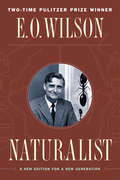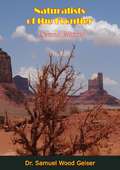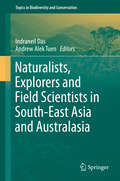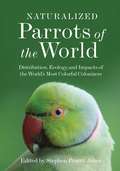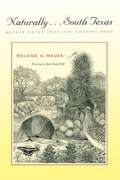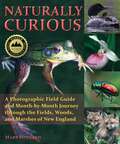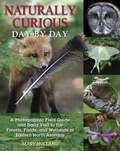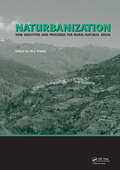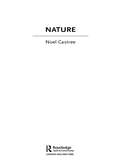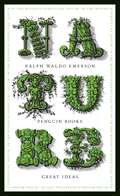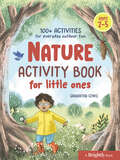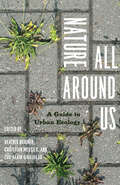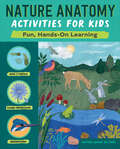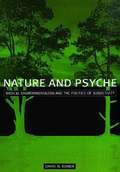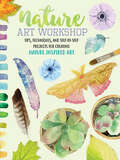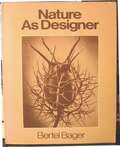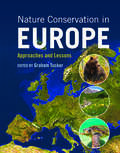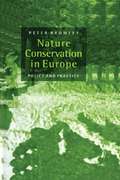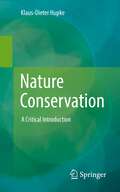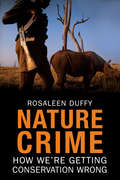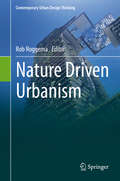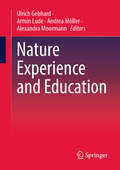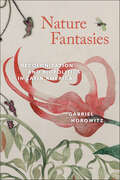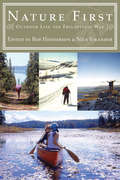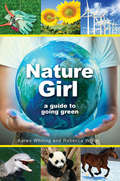- Table View
- List View
Naturalist: Conservation And Development In The Maya Forest Of Belize (Naturalist Directory And Almanac Ser.)
by Edward O. WilsonEdward O. Wilson -- University Professor at Harvard, winner of two Pulitzer prizes, eloquent champion of biodiversity -- is arguably one of the most important thinkers of the twentieth century. His career represents both a blueprint and a challenge to those who seek to explore the frontiers of scientific understanding. Yet, until now, little has been told of his life and of the important events that have shaped his thought.In Naturalist, Wilson describes for the first time both his growth as a scientist and the evolution of the science he has helped define. He traces the trajectory of his life -- from a childhood spent exploring the Gulf Coast of Alabama and Florida to life as a tenured professor at Harvard -- detailing how his youthful fascination with nature blossomed into a lifelong calling. He recounts with drama and wit the adventures of his days as a student at the University of Alabama and his four decades at Harvard University, where he has achieved renown as both teacher and researcher.As the narrative of Wilson's life unfolds, the reader is treated to an inside look at the origin and development of ideas that guide today's biological research. Theories that are now widely accepted in the scientific world were once untested hypotheses emerging from one mans's broad-gauged studies. Throughout Naturalist, we see Wilson's mind and energies constantly striving to help establish many of the central principles of the field of evolutionary biology.The story of Wilson's life provides fascinating insights into the making of a scientist, and a valuable look at some of the most thought-provoking ideas of our time.
Naturalists of the Frontier [Second Edition]
by Dr Samuel Wood GeiserThis acclaimed study of the history of scientific exploration in the Southwest from renowned biologist Dr. Samuel Wood Geiser, first published in its present revised edition in 1948, would be of interest to many types of readers:For those who love stories, of adventure and struggle, it narrates the lives and varying fates of men who lived under strange and difficult conditions, and who met those conditions, some with heroic resolution and resourcefulness, some with fainting and failure, many with a mixture of both. These lives are presented, not in the style of the popular semi-fiction of the day, but with such accuracy as only a thorough study of many sorts of records makes possible; yet, too, with sympathy and insight into human nature throughout.For those interested in, frontier life and frontier stories this book presents an unwonted aspect of that life: the struggle for culture and for science under frontier conditions: a struggle no less heroic than that of the fighting pioneer. Naturalists of the Frontier realistically portrays the hard material conditions of frontier life, yet these are illumined by the ideals of the men who subdued those conditions.The student of the early history of the Southwest, and particularly of Texas, will find here presented unusual and significant aspects of that history. For the historian of science this book pictures the beginnings of science in a new country; it shows what science must be under frontier conditions—an examination of the resources of the region, rather than a study of underlying problems.
Naturalists, Explorers and Field Scientists in South-East Asia and Australasia
by Indraneil Das Andrew Alek Tuen"Alfred Russel Wallace- His Predecessors and Successors. Naturalists, Explorers and Field Scientists in South-east Asia and Australasia. An International Conference" will be the premier forum for the presentation of new advances and research results in the fields of studies on Alfred Russel Wallace and other natural historians, past and present, as well as contemporary research on South-east Asian and Australasian biological diversity. The conference will bring together leading researchers including biologists, ecologists, zoologists, botanists, geologists, anthropologists, social scientists and others from around the world. Topics of interest include, but are not limited to: history of biology, biodiversity, anthropology, geology, conservation, ecosystem management, environmental impact assessments, environmental law, environmental policies, landscape management and habitat restoration and management.
Naturalized Parrots of the World: Distribution, Ecology, and Impacts of the World's Most Colorful Colonizers
by Stephen Pruett-JonesA remarkable exploration of naturalized parrots, among the most widely distributed birds in the worldThere are more than 350 species of parrots in the world, and approximately 300 of these species have been transported to other countries through the caged pet trade. Whether through escaped captivity or purposeful release, many of these parrots are now breeding in new habitats. Indeed, no less than 75 species of parrots have established breeding populations in countries where they were introduced, and parrots are now among the most widely distributed group of birds. Naturalized Parrots of the World is the first book to examine this specific avian population.Bringing together the work of leading researchers in one convenient volume, this book explores the biology of naturalized parrots and their interactions with native ecosystems. Experts discuss the global distribution of parrots, their genetics, conservation implications, and human responses to these birds. They also consider debates surrounding management issues and the lack of consensus around nonnative species in the wild. Later chapters feature case studies of the two most successful species—the Rose-ringed Parakeet and Monk Parakeet—as well as studies of the introduced parrot species located in specific countries and regions, including the United States, United Kingdom, Spain, Portugal, northern Europe, South Africa, and Australia.Highlighting critical aspects of conservation biology and biodiversity, Naturalized Parrots of the World will be an invaluable resource for parrot owners, ornithologists, conservation biologists, and birdwatchers.
Naturally ... South Texas
by Roland H. Wauer"I believe this book will be read and enjoyed even by those who have ventured no further afield than a chigger bite as a casualty of a backyard barbecue. "--David H. Riskind, Director, Natural Resources Program, Texas Parks and WildlifeThe Golden Crescent of South Texas, a fifteen-county region along and inland from the middle Gulf Coast, is often called "the Crossroads" because of its natural diversity. Located in the heart of the Gulf Coast Prairie and Marshes, the area also encompasses the trailing edges of the South Texas Plains, Post Oak Savannah, and Blackland Prairie. This confluence of ecological zones makes it a wonderful place for birding and for observing the changing face of nature, especially during seasonal transitions. In this book, Ro Wauer describes a typical year in the natural life of South Texas. Using selected entries from his weekly column in the Victoria Advocate newspaper, he discusses numerous topics for each month, from the first appearance of butterflies in January, to alligators making a comeback in July, to the Christmas bird count in December. His observations are filled with intriguing natural history lore, from what sounds mockingbirds will imitate (almost any noise in their neighborhood) to how armadillos swim (by inflating themselves to increase their buoyancy).
Naturally Curious
by Mary HollandAre you ready for a glimpse into the dark, subterranean world of the star-nosed mole? A barred owl's late-winter call to take on new meaning? The life cycle of the eastern newt to suddenly seem complex, beautiful, and intricately bound to mysterious underwater landscapes and damp forest floors? Naturalist and environmental educator Mary Holland's visually astounding book Naturally Curious promises a walk in the woods (or a field or wetland) will never be the same. With boundless enthusiasm and a lifetime's-worth of natural history knowledge, Holland escorts you through the New England seasons, month by month—in sun, rain, and snow; along roadsides and riverbanks; above burrows and under treetop nesting sites. Beginning with March and its early stirrings of life awakening after a long cold winter, and ending in February as survival becomes the sole focus of all plants and creatures, great and small, Holland provides hundreds of fascinating Nature Notes. These bite-size nuggets of fact-based information detail a species' actions in a particular month—whether courting, breeding, singing, burrowing, migrating, or caching food, for example. In addition, you'll find pertinent lists of the amphibians, reptiles, birds, mammals, insects and arachnids, and plants and fungi you might expect to see or hear from as the weeks go by. But that's not all: Each month culminates in specially chosen essays, where Holland gets up-close-and-personal with New England plant and animal life and some of their more intriguing typicalities and peculiarities, illustrating their impact on the region and those who share it. Throughout, the many exciting and varied worlds of the Northeast explode upon the page in an unmatched visual display of full-color photographs. From the minutiae (the migration of the tiny snow flea on a warm winter's day) to the massive (the wallowing practices of the bull moose in rut) this is the region and its inhabitants like you've never seen them before. By deftly melding the practical field guide we all need with the kind of book we all want to sit back and read, Holland does New England—and those who live in it, visit it, and love it—an immense service. Adults and children alike are sure to be fascinated by the natural world in this book, in their backyard, and even further afield. Naturally Curious is truly an into this world experience.
Naturally Curious Day by Day: A Photographic Field Guide and Daily Visit to the Forests, Fields, and Wetlands of Eastern North America
by Mary HollandThis follow-up to Naturally Curious, a National Outdoor Book Award winner, is a day-by-day account of nature observations throughout the year. Daily entries include entertaining and enlightening observations about specific animal or plant activity happening in eastern North America on that date.Set up as a naturalist's journal, entries describe in detail sightings and events in the natural world and are accompanied by stunning color photographs of birds, animals, insects, plants, and more. Essays throughout describe specific events in nature happening during each month, while sidebars supply natural history facts and information pertinent to the topics of the month or the time of year.
Naturbanization: New identities and processes for rural-natural areas
by M. J. PradosAs the growth of the worlds population requires the continued search for residential space, the urbanization of natural lands is an inevitable process, but that process does not have to be one that is accomplished without regard for environmental quality. This book presents the unique perspective of naturbanization, the urbanization of protected a
Nature
by Noel CastreeExploring the shifting ways in which geographers have studied nature, this book emphasizes the relationships and differences between human geography, physical geography and resource and hazards geography. The first to consider the topic of nature in modern geography as a whole, this distinctive text looks at all its major meanings, from the human body and psyche through to the non-human world, and develops the argument that student readers should abandon the idea of knowing what nature is in favour of a close scrutiny of what agendas lie behind competing conceptions of it. It deals with, amongst others, the following areas: the idea of nature the 'nature' of geography de-naturalization and re-naturalization after-nature. As everything from global warming to GM foods becomes headline news, the use and abuse of nature is on the agenda as never before. Synthesizing a wealth of diverse and complex information, this text makes the significant theories, debates and information on nature accessible to students of geography, environmental studies, sociology, and cultural studies.
Nature (Penguin Great Ideas)
by Ralph EmersonOriginally published anonymously, Nature was the first modern essay to recommend the appreciation of the outdoors as an all-encompassing positive force. Emerson’s writings were recognized as uniquely American in style and content, and launched the idea of going for a walk as a new way of looking at the world. Throughout history, some books have changed the world. They have transformed the way we see ourselves – and each other. They have inspired debate, dissent, war and revolution. They have enlightened, outraged, provoked and comforted. They have enriched lives – and destroyed them. Now Penguin brings you the works of the great thinkers, pioneers, radicals and visionaries whose ideas shook civilization and helped make us who we are.
Nature Activity Book for Little Ones: 100+ Activities for Everyday Outdoor Fun
by Samantha LewisIntroduce your little one to the wonders of nature with 100+ outdoor learning activities!Give your child all the benefits of nature with this activity book designed for children ages 2-5. Whether you&’re planning an afternoon in a local park, a day in the backyard, or a morning hike in a nature preserve, you and your child will find more than 100 ideas in these pages for observing, exploring, creating, and playing in nature.Nature Activity Book for Little Ones features: • 100+ outdoor activities for kids ages 2-5, geared toward their interests and developmental milestones—with little or no preparation required • Bonus activities for additional learning, including numbers, letters, shapes, and colors • School prep: the activities teach problem-solving, communication, and responsibility, important skills for school succes • Less screen time and more nature time together to fuel your child&’s curiosity and creativity and help them build an early connection with natureBest of all, this entertaining book provides more than a hundred ways to keep your child moving and occupied and for you to bond with your child, all in nature!
Nature All Around Us: A Guide to Urban Ecology
by Beatrix Beisner, Christian Messier, and Luc-Alain GiraldeauIt’s easy to stand in awe of a city’s impressive skyline, marveling at its buildings reaching for the clouds and its vast network of roadways and train lines crisscrossing in every direction. It can often seem like everything in a city is man-made, all concrete, steel, and glass. But even the asphalt jungle is not all asphalt—a sidewalk’s cracks are filled with nature, if we know where and how to look. To aid us in this quest is Nature All Around Us, which will help us to recognize (and look after) the natural world we traipse through in our daily lives. Nature All Around Us uses the familiar—such as summer Sundays humming with lawn mowers, gray squirrels foraging in planters, and flocks of pigeons—in order to introduce basic ecological concepts. In twenty-five short chapters organized by scale, from the home to the neighborhood to the city at large, it offers a subtle and entertaining education in ecology sure to inspire appreciation and ultimately stewardship of the environment. Various ecological concepts that any urban dweller might encounter are approachably examined, from understanding why a squirrel might act aggressively towards its neighbor to how nutrients and energy contained within a discarded apple core are recycled back into the food chain. Streaming through the work is an introduction to basic ecology, including the dangers of invasive species and the crucial role played by plants and trees in maintaining air quality. Taken as a whole, Nature All Around Us is an unprecedented field guide to the ecology of the urban environment that invites us to look at our towns, cities, and even our backyards through the eyes of an ecologist. It is an entertaining, educational, and inspiring glimpse into nature in seemingly unnatural settings, a reminder that we don’t have to trek into the wild to see nature—we just have to open our eyes.
Nature Anatomy Activities for Kids: Fun, Hands-On Learning (Anatomy Activities for Kids)
by Kristine BrownThink like a scientist and search like an explorer with this illustrated nature guide for kids ages 8 to 12Get ready to explore the sky above, the ground below, and all the plants and creatures in between! Made just for kids, this nature anatomy book teaches you about the incredible forces and living things that exist in nature.You'll dig in to tons of different topics—from naming the layers of the atmosphere to learning the parts of a flower—and try out fun activities like creating a mini cloud and raising a tadpole. As you explore the natural world around you, you'll become a real scientist by asking questions, imagining outcomes, testing your ideas, and then writing down what you discover.Nature Anatomy Activities for Kids includes:5 Subjects, 20 lessons—Dive in to different chapters for the earth, the sky, water, plants, and animals. Every chapter includes multiple lessons about the topic, with a new activity and a journal prompt for each.Journal like a scientist—Use your own blank journal to answer prompts and take notes so you can write and draw everything you observe or note any questions you want to find an answer for.Detailed illustrations—Colorful pictures and diagrams make this nature anatomy book fun to use and get kids excited about the anatomy of plants, animals, ecosystems, and landscapes.Get outside and explore with this book of nature anatomy activities that opens up a whole new world of learning.
Nature And Psyche: Radical Environmentalism And The Politics Of Subjectivity
by David KidnerNature and Psyche argues that psychological and environmental writing and action are all too often colonized by the same assumptions that inhibit ecological and cultural diversity. Industrialized monocultures conceal the character of our alienation from nature and, thus, prevent the emergence of effective solutions. Drawing on a diversity of disciplines, David Kidner illustrates that traditional psychological understanding is often inherently hostile to the natural order, and that the dominant form of selfhood that has emerged in the industrialized world promotes the domestication of nature. In fact, even some of the most radical environmentalists, who simplistically oppose technology, are also trapped within this paradigm. The author demonstrates that a more critical historical and cultural awareness, rooted in nature, can enable a re-integration of nature and psyche.
Nature Art Workshop: Tips, Techniques, and Step-by-Step Projects for Creating Nature-Inspired Art
by Sarah Lorraine Edwards Mikko Sumulong Alyssa Stokes Katie BrooksA visual resource for artists and crafters who want to combine their talents with their love of the natural world.Each page of Nature Art Workshop engages, inspires, and encourages artists to see the world around them in a new light while they learn to create their own nature-inspired art.Four talented visual nature artists guide you through finding and prepping traditional media and natural elements to use in creating unique nature-inspired projects, following simple step-by-step instructions. Projects include a pressed-flower ceramic dish, fresh floral crown, and flower-adorned candles, in addition to painted feathers, stones, shells, leaves, and more. Valuable art tips and techniques offer guidance during the artistic process.A fun, refreshing approach to mixed-media art, Nature Art Workshop proves that you can turn anything into a stunning work of art with the right materials and a bit of imagination.
Nature As Designer: A Botanical Art Study
by Bertel BagerFrom Foreword: "...Dr. Bertel Bager, who has written, collected and assorted the material for this book over a long period of years, is a man who has long been associated with both art and nature. In addition to his position of chief surgeon at one of the largest hospitals in Sweden, he has made the study of design and nature his avocation. He annually enjoys tours of discovery in the Swedish countryside, searching the grasses and thistles, mosses and lichens, usually finding something worth collecting and meditating upon. Not primarily interested in bright colors, he is fasxcinated by meadows at the time they hav ebeen deserted by butterflies, and by mountain forests, the realm of timeless lichens and mosses. Long after the meadow has lost its summer glory, he seeks the unappreciated - the fruits and seedpods - swaying and rustling in the autumn winds. When winter comes, he stands meditating upon the expressive play of shadows of dead plants on the snow. What Bager is seeking above all, is the beauty of form in nature. Displayed in many cabinets is his treasured collection of specimens amassed over the years, much like a gallery, showing the fascinating forms of simple things in nature and emphasizing the theme, 'Nature as Designer.' This volume is a guided tour through part of these treasures but is meant to stimulate interest in form and to please the eye, which is the primary purpose of an illustrated book." Softcover, 8 x 10 inches, 176 pages, 191 black and white photographs.
Nature Conservation in Europe: Approaches and Lessons
by Graham TuckerEuropean ecosystems and species remain under pressure from intensive agriculture and forestry, fishing, pollution, urban sprawl, invasive species and climate change. This book provides a detailed description and critical analysis of nature conservation responses, achievements and failures, motivated by the concerning state of nature and missed biodiversity targets. It summarises Europe's nature and the impact of human activities, and then gives an overview of relevant international biodiversity treaties and the EU nature conservation policy and legislative framework. The core of the book comprises chapters written by national experts, which cover the UK and twenty-five EU Member States, providing comparative case studies from which valuable lessons are drawn. Covering wide-ranging topics such as biodiversity pressures, legislation and governance, biodiversity strategies, species protection, protected areas, habitat management, and funding, this book is of interest to a wide audience, including academics and professionals involved in nature conservation and related environmental fields.
Nature Conservation in Europe: Policy and Practice
by Peter BromleyThe Rio Summit has pointed to the urgency for the development of an international conservation policy; and the post-Maastricht debates in Europe have highlighted the need for the EU to reassess structural funding in nature conservation, as well as the influences on policy and practice.This book is a 'route map' through the legislative and policy frameworks and explains how conservation works in Europe. It goes through the policies for nature conservation in the European Community and its constituent member states and sets out the mechanisms for delivering this policy.An understanding of the European legislative framework is now vital as its influence on local practice increases. Practitioners in the fields of countryside conservation and general land management will find the book an essential guide to the working of the EU, as well as helping an appreciation of their local role within the wider community objectives. This will, for example allow a better understanding of the grant system which many managers are now using.
Nature Conservation: A Critical Introduction
by Klaus-Dieter HupkeMany things happen in nature reserves that are contradictory at first glance. For example, flower meadows are mown down during maintenance work, even though all the plants growing there are protected. Elsewhere, protected reed beds are burnt down in a fen or the top layer of soil is removed with bulldozers in a dune conservation area. Still other areas are to remain completely untouched by human intervention. The author Klaus-Dieter Hupke shows the different strategies of nature conservation. He also shows that nature conservation is mostly not exactly what the term says in essence: "protection of nature". On the contrary, in Central Europe nature conservation areas are predominantly the relics of old agricultural and thus cultural landscapes. Often, aesthetic aspects of a landscape section are also in the foreground when designating it as a natural monument or nature reserve. Moreover, nature conservation runs the risk of becoming a substitute action and an alibi for a still growing destruction of traditional and near-natural landscape systems in Central Europe as well as globally.The updated second edition now explicitly includes the consequences of climate change for nature conservation and has also incorporated a stronger reference to Austria as well as to the central Alpine region in some places for the relevant readers.
Nature Crime
by Rosaleen DuffyIn this impressively researched, alarming book, Rosaleen Duffy investigates the world of nature conservation, arguing that the West's attitude to endangered wildlife is shallow, self-contradictory, and ultimately very damaging. Analyzing the workings of the black-market wildlife industry, Duffy points out that illegal trading is often the direct result of Western consumer desires, from coltan for cellular phones to exotic meats sold in London street markets. She looks at the role of ecotourism, showing how Western travelers contribute--often unwittingly--to the destruction of natural environments. Most strikingly, she argues that the imperatives of Western-style conservation often result in serious injustice to local people, who are branded as "problems" and subject to severe restrictions on their way of life and even extrajudicial killings.
Nature Driven Urbanism (Contemporary Urban Design Thinking)
by Rob RoggemaThis book discusses the way that a nature-driven approach to urbanism can be applied at each of the urban scales; architectural design, urban design of neighborhoods, city planning and landscape architecture, and at the city and regional scales. At all levels nature-driven approaches to design and planning add to the quality of the built structure and furthermore to the quality of life experienced by people living in these environments. To include nature and greening to built structures is a good starting point and can add much value. The chapter authors have fiducia in giving nature a fundamental role as an integrated network in city design, or to make nature the entrance point of the design process, and base the design on the needs and qualities of nature itself. The highest existence of nature is a permanent ecosystem which endures stressors and circumstances for a prolonged period. In an urban context this is not always possible and temporality is an interesting concept explored when nature is not a permanent feature. The ecological contribution to the environment, and indirect dispersion of species, from a temporary location will, overall add biodiversity to the entire system.
Nature Experience and Education (Contributions from Biology Education Research)
by Ulrich Gebhard Armin Lude Andrea Möller Alexandra MoormannExperiencing nature has positive effects on mental development, health, and well-being, and can be interpreted as an element of a &“good life.&” This book relates this connection to learning and educational settings. Educational processes in biology education are defined not only by the acquisition of relevant subject matter but also about the encounter, confrontation, and transformation of the self. The central assumptions of this book are, firstly, that the latter can be facilitated through nature experiences, and secondly, that this can also positively influence (subject-specific) learning processes.
Nature Fantasies: Decolonization and Biopolitics in Latin America (Bucknell Studies in Latin American Literature and Theory)
by Gabriel HorowitzIn this original study, Gabriel Horowitz examines the work of select nineteenth- and twentieth-century Latin American writers through the lens of contemporary theoretical debates about nature, postcoloniality, and national identity. In the work of José Martí, Gertrudis Gómez de Avellaneda, Jorge Luis Borges, Augusto Roa Bastos, Cesar Aira, and others, he traces historical constructions of nature in regional intellectual traditions and texts as they inform political culture on the broader global stage. By investigating national literary discourses from Cuba, Argentina, and Paraguay, he identifies a common narrative thread that imagines the utopian wilderness of the New World as a symbolic site of independence from Spain. In these texts, Horowitz argues, an expressed desire to return to the nation’s foundational nature contributed to a movement away from political and social engagement and toward a “biopolitical state,” in which nature, traditionally seen as pre-political, conversely becomes its center.
Nature First: Outdoor Life the Friluftsliv Way
by Bob Henderson Nils VikanderNature First combines the Scandinavian approach to creating a relationship with nature (known as friluftsliv) with efforts by Canadian and international educators to adapt this wisdom and apply it to everyday life experiences in the open air. The word friluftsliv literally refers to "free-air life" or outdoor life. A word saturated with values, the concept can permeate deeply and playfully into ones cultural being and personal psyche, thus influencing the way one perceives and interacts with nature on a daily basis. For centuries, the North American approach has been one of domination and bringing nature under control, in many cases abusing our natural environment in the process. The friluftsliv way of being on "talking terms with nature," developing an "insider’s" relationship with nature, offers the rich potential of allowing us as cohabiters on the Earth to recreate, rejuvenate and restore the balance among all living things. Nature First is the first English-language anthology to bring together the perspectives and experiences of North American, Norwegian, Swedish and other international outdoor writers, all friluftsliv thinkers and doers. Here, the thirty contributors’ use of history, sociology, psychology, philosophy and outdoor education writings blend to provide an understanding of how friluftsliv applies to everyday life. The book presents an alternative to much of the personal growth/adventure-based literature that tends to dominate our current approach to the outdoor activity. Folklore, heritage, adventure travel, crafts, place-based education and the daily outings of families all have a role to play in promoting an understanding of both the ordinary and the mystical importance of this Nordic tradition. Dedicated to parents, travel guides, educators and generally to participants in the outdoors, Nature First provides a compellingly fresh approach to life in the out-of-doors.
Nature Girl: A Guide to Caring for God's Creation
by Karen Whiting Rebecca WhiteLove God, Love the Planet As you become an expert in all things green, Nature Girl offers fun ways to care for God’s creations while enjoying the wonders of nature! With activities, recipes, science experiments, and much more, you can discover how to create recycled jewelry, plan a spa day with friends, make your own earth-friendly skin care products, or team up to clean a park or a neighbor’s yard. Each chapter covers different topics, like water, air, energy, and recycling, and includes crafts, Scripture, games, quizzes, interviews with experts, and quotes from real girls like you. From the itty-bitty flowers at your feet to the air high above your head, discover how you can make a difference for our planet.
